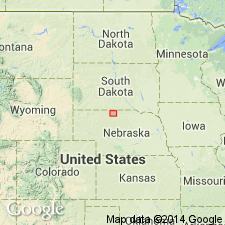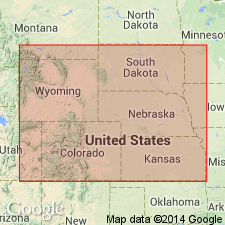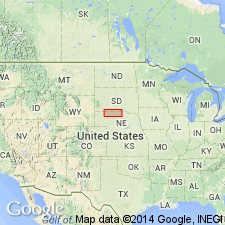
- Usage in publication:
-
- Burge sands member
- Modifications:
-
- Original reference
- Dominant lithology:
-
- Sand
- AAPG geologic province:
-
- Chadron arch
Summary:
Pg. 467-473. It is proposed to call the extensive channel deposits that contain the "Burge fauna" (described by R.A. Stirton and P.O. McGrew, Amer. Jour. Sci., 5th series, v. 29, p. 125-132, 1935) the Burge sands member of Ogallala formation. The beds consist of unconsolidated, fine- to coarse-grained, gray, cross-bedded, channel sands, often containing nodules and lenses of greenish clay; coarse sand and some gravel noted in nearly all exposures. Thickness 25 to 28 feet at Burge Quarry; varies up to 30 feet in other places. Overlain by "cap rock bed" (highly calcareous grit), and in many places rest unconformably on greenish-gray massive sands of upper part of Valentine beds. Burge sands and "cap rock bed" assigned to lower Pliocene, and Valentine beds to transitional Miocene-Pliocene. The beds and their fauna have been traced from Cherry County into Brown County, by M.F. Skinner.
Type locality: Burge quarry, [on east side of Snake River, in N/2 NW/4 SE/4 sec. 15, T. 32 N., R. 30 W.], southwest of Valentine, Cherry Co., central northern NE.
Source: US geologic names lexicon (USGS Bull. 896, p. 295).

- Usage in publication:
-
- Burge channel member
- Modifications:
-
- Revised
- AAPG geologic province:
-
- Chadron arch
Summary:
Pg. 223, 227. Referred to as Burge channel member of Valentine formation redefined and assigned to Ogallala group (redefined). Occurs at top of formation. [Age is Pliocene.]
[See also GSA Bull., v. 50, no. 8, p. 1260, 1264 (table 1), 1939.]
Source: US geologic names lexicon (USGS Bull. 1200, p. 537).

- Usage in publication:
-
- Burge channel
- Modifications:
-
- Revised
- AAPG geologic province:
-
- Chadron arch
Summary:
Pg. 137-138. Highest known fauna from the Valentine comes from Burge channel quarries. It seems best not to consider the Burge a channel member but merely a channel within the undivided Valentine. Age is Pliocene.
Source: US geologic names lexicon (USGS Bull. 1200, p. 537).

- Usage in publication:
-
- Burge Member
- Modifications:
-
- Areal extent
- AAPG geologic province:
-
- Chadron arch
- Salina basin
Summary:
Pg. 230 (fig. 3), 246 (fig. 4), 252, 284-293, 294 (fig. 13), 303 (fig. 15), 338-345 (figs. 32-38). Burge Member of Valentine Formation of Ogallala Group. Channel deposits. Consists of cross-bedded loose quartz sand and greenish-gray to olive-green quartz pebbles. Frequently contains greenish clay ball clasts, particularly in its basal part where vertebrate fossils (notably Burge local fauna) are found. Lenses of greenish clay occur at various levels. Thickness 0 to 50 feet. Is uppermost member of the Valentine Formation. Unconformably underlies Cap Rock Member of Ash Hollow Formation of Ogallala Group, which includes the Swallow ash (10.6 +/-0.2 Ma, Boellstorff and Skinner, 1977, p. 40) at its base. Unconformably overlies Devil's Gulch Member of Valentine. Age is [early late] Miocene (Valentinian NALMA; early Clarendonian NALMA of some paleontologists). [On p. 252, authors state Valentinian is applied to faunas that occur in the Valentine Formation and the Valentinian represents a period of possibly 3 m.y. duration. Some paleontologists place the Valentine Formation in the middle Barstovian to early Clarendonian NALMA.]
Source: Publication.
For more information, please contact Nancy Stamm, Geologic Names Committee Secretary.
Asterisk (*) indicates published by U.S. Geological Survey authors.
"No current usage" (†) implies that a name has been abandoned or has fallen into disuse. Former usage and, if known, replacement name given in parentheses ( ).
Slash (/) indicates name conflicts with nomenclatural guidelines (CSN, 1933; ACSN, 1961, 1970; NACSN, 1983, 2005, 2021). May be explained within brackets ([ ]).

